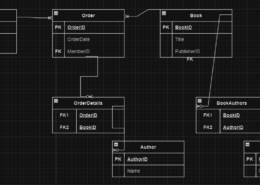why Microsoft server down all over the world?
To draw an Entity-Relationship (E-R) diagram for the described Book Club scenario, we need to identify the entities, relationships, and cardinalities. Here’s a breakdown of the entities and their relationships: Entities: Member Order Book Author Publisher Relationships: Places: Between Member and OrRead more
To draw an Entity-Relationship (E-R) diagram for the described Book Club scenario, we need to identify the entities, relationships, and cardinalities. Here’s a breakdown of the entities and their relationships:
Entities:
- Member
- Order
- Book
- Author
- Publisher
Relationships:
- Places: Between Member and Order
- Contains: Between Order and Book
- Writes: Between Author and Book
- Publishes: Between Publisher and Book
Cardinalities:
- A Member can place zero or more Orders.
- An Order contains one or more Books.
- A Book can be written by one or more Authors.
- An Author can write one or more Books.
- A Book is published by one Publisher.
- A Publisher can publish one or more Books.
Assumptions:
- Each Order is placed by one Member.
- Each Book is contained in one or more Orders.
Here’s the E-R diagram representation in text form:
- Member (MemberID, Name, Email)
- Order (OrderID, OrderDate, MemberID)
- Member and Order have a one-to-many relationship (One Member places many Orders).
- Book (BookID, Title, PublisherID)
- Order and Book have a many-to-many relationship through a junction table (OrderDetails with OrderID and BookID).
- Author (AuthorID, Name)
- Book and Author have a many-to-many relationship through a junction table (BookAuthors with BookID and AuthorID).
- Publisher (PublisherID, Name, Address)
- Publisher and Book have a one-to-many relationship (One Publisher publishes many Books).
Description:
- Member (MemberID, Name, Email)
- A Member entity with attributes MemberID, Name, and Email.
- One-to-Many relationship (Places) with Order.
- Order (OrderID, OrderDate, MemberID)
- An Order entity with attributes OrderID, OrderDate, and MemberID (foreign key).
- Many-to-Many relationship (Contains) with Book through OrderDetails.
- OrderDetails (OrderID, BookID)
- Junction table to represent the many-to-many relationship between Order and Book.
- Contains attributes OrderID and BookID (foreign keys).
- Book (BookID, Title, PublisherID)
- A Book entity with attributes BookID, Title, and PublisherID (foreign key).
- Many-to-Many relationship (Written by) with Author through BookAuthors.
- Author (AuthorID, Name)
- An Author entity with attributes AuthorID and Name.
- Many-to-Many relationship (Writes) with Book through BookAuthors.
- BookAuthors (BookID, AuthorID)
- Junction table to represent the many-to-many relationship between Book and Author.
- Contains attributes BookID and AuthorID (foreign keys).
- Publisher (PublisherID, Name, Address)
- A Publisher entity with attributes PublisherID, Name, and Address.
- One-to-Many relationship (Publishes) with Book.


Microsoft experienced a global outage on July 19, 2024, due to a technical issue with a CrowdStrike software update. CrowdStrike, a leading cybersecurity provider for Microsoft Windows devices, inadvertently triggered a widespread disruption in Microsoft services, including Azure, Teams, and OutlookRead more
Microsoft experienced a global outage on July 19, 2024, due to a technical issue with a CrowdStrike software update. CrowdStrike, a leading cybersecurity provider for Microsoft Windows devices, inadvertently triggered a widespread disruption in Microsoft services, including Azure, Teams, and Outlook. The faulty update caused a cascade of failures, rendering systems temporarily unusable and impacting users worldwide. This outage is particularly noteworthy due to the fact that it was caused by a security update, which is generally expected to enhance system safety and stability.
The outage caused significant disruptions across various sectors. Airlines faced delays due to check-in and boarding issues, financial institutions reported service disruptions, hospitals experienced difficulties accessing patient records, and countless businesses relying on Microsoft services were severely impacted. Microsoft acknowledged the issue and worked to resolve it promptly, isolating the faulty update and deploying a fix. While the outage caused temporary inconvenience, it highlighted the critical importance of cybersecurity software, the vulnerability of interconnected systems, and the potential for widespread disruptions caused by software glitches, even those designed to enhance security. The incident emphasized the need for rigorous testing and robust contingency plans for critical software updates to minimize the impact of incidents in the future.
See less